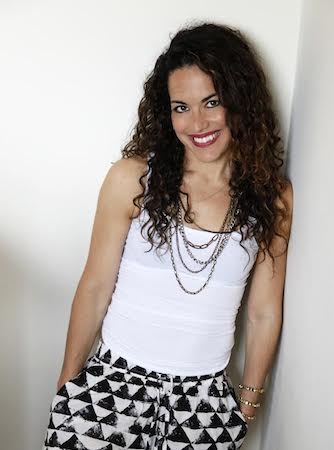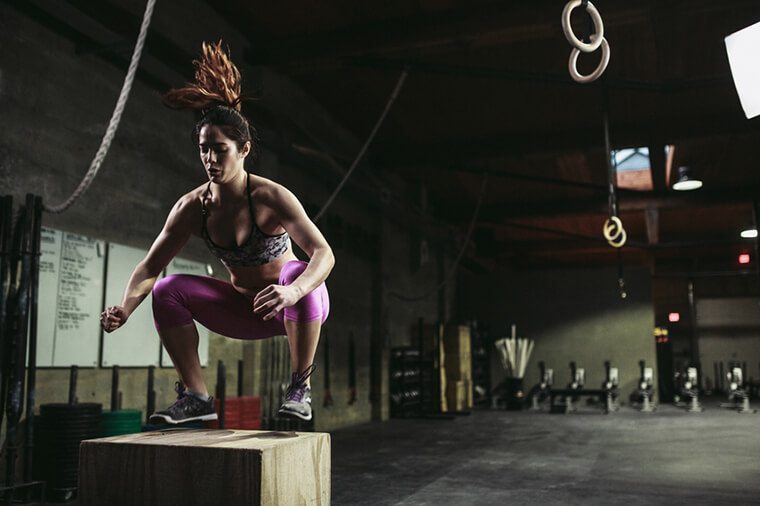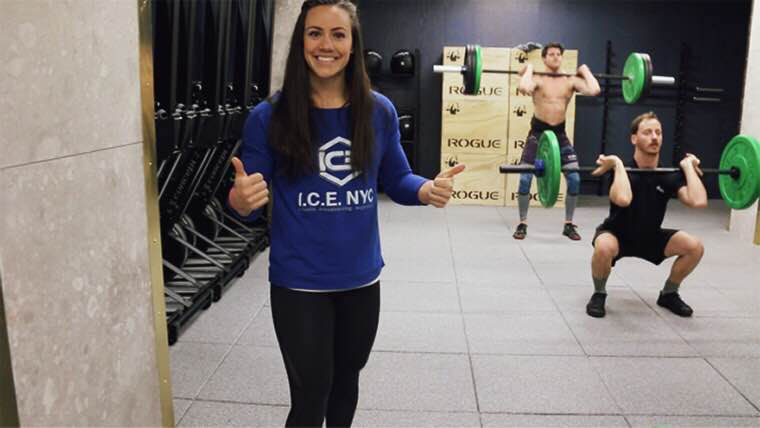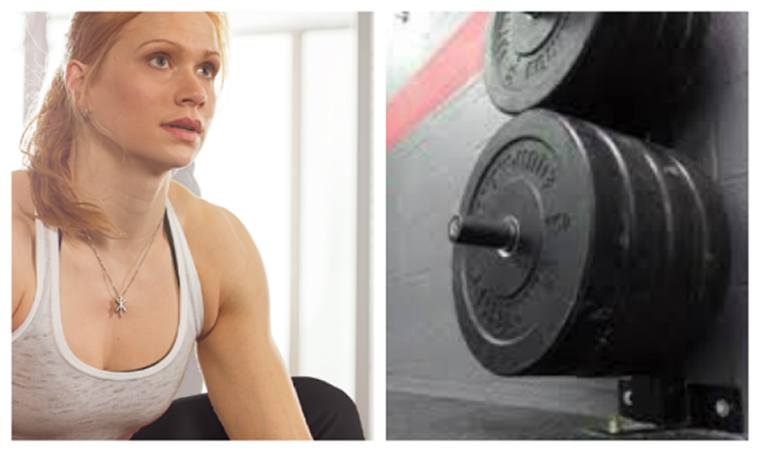The Rise of Women in Crossfit: It’s Not All Deadlifts and Roses

Meet Well+Good’s fitness historian, Natalia Petrzela, PhD, a history professor at The New School in New York City and a premier IntenSati instructor, who shares the sweaty past with us in this column.
For a Good Time, Call Fran, 21:15:9 might look like men’s room graffiti. Unless, of course, you’re one of the millions CrossFit enthusiasts around the world who gets the inside joke.
Often stamped on t-shirts stretched across the chests of sculpted CrossFitters, the cryptic slogan refers to one of the super-popular fitness brand’s most challenging WODS, or Workouts Of the Day, all of which are named for women. And maybe not so flatteringly.
Co-founder Greg Glassman bluntly christened the famous “Fran” WOD because “anything that left you flat on your back, looking up at the sky asking ‘what just happened to me?’ deserved a female’s name.” (The digits aren’t a phone number incidentally, but a specific sequence of thrusters and pull-ups.)
Maybe this talk is just the kind of bro-ish ribbing one would expect at a CrossFit “box” (or gym, in CF parlance) where the aesthetic is industrial and the clientele is about 50 percent male, exceptionally high for the group fitness space, which is typically dominated by women.
Yet the ladies seem to love it.

{{post.sponsorText}}
CrossFit might not sound like a feminist utopia, but women are flocking to boxes worldwide to embark on its Olympic-like feats of strength and the occasionally vomit-inducing pursuit of “breathing fire,” a decidedly different goal than the (still!) ubiquitously marketed “bikini body.” And in fact at this week’s CrossFit Games, there are dozens of super-buff women competing right now.
Why women are increasingly into CrossFit is not so obvious.
Founded in 2000 by Glassman and his then-wife Lauren Jenai, Crossfit began as a kind of throwback: a high-intensity, low-tech alternative to mainstream, increasingly big-box and cardio-focused fitness culture that had transformed gyms from sweaty, windowless dungeons into swanky studios and health clubs (from Pumping Iron to Perfect, for visuals) populated by greater numbers of women.
“There’s no such thing as a male or female workout—we all do the same exercises."
While “working out” had once referred to a subculture of mostly men lifting heavy weights to bulk up, by the 1970s, a growing body (ahem) of research celebrated the health and aesthetic benefits of cardio, most famously inspiring the jogging phenomenon but also the fitness-i-fication of choreographed workouts designed and frequented by a female clientele who’d been previously excluded from these ancestors of the modern-day #fitfam.
As a generation of women who'd grown up with Title IX came of age, acceptance and even celebration of women’s athleticism grew. This sweaty new scene both championed active womanhood (one woman I interviewed recalled that “Jane Fonda made me proud to exercise in public”), and embraced conventional notions of femininity—think pink weights, a focus on weight-loss, and the birth of fitness fashion, which, for the first time, gave women wicking, “butt-sculpting” leggings instead of smaller versions of men’s clothes.
CrossFit can feel like a rejection of all of the above, from steady-state cardio to sleek fitness studios that make spaces, well, pretty.
The peculiar gender dynamics of CrossFit culture
But back to the language issue. While almost forty years ago, feminists successfully pressured the National Weather Service to stop the misogynist practice of naming storms only after women, Fran’s origin story suggests that the idea of female strength as destructive and domineering is core to the CrossFit vision. A female coach told me with the equivalent of a verbal eye roll, that while she isn’t personally offended, “the Fran story” is also known to be “obviously sexual.”
In 2003, Glassman described the “Nasty Girls” WOD series with similarly masochistic relish; “the crushing charm of these ladies is in their ability to root out weaknesses and humiliate you with them.” (Online conversations articulate these attitudes even more intensely; check out any thread about Glassman and Jenai’s acrimonious divorce at your peril.) By contrast, the “Heroes” WODS, soberly named in honor fallen soldiers, are almost exclusively male. It doesn’t take a genius to spot that stereotype from 100 yards (of a sprint dash) away.
Not surprisingly, CrossFit boxes forgo the feel-good, you-go-girl affirmations adorning the walls of dance cardio studios for gruff commands to “HTFU” (that’s “harden the F up”) while enduring “the pain cave.” Online chatter in CrossFit forums can tend to war stories about throwing up after a tough workout (affectionately styled “meeting Uncle Pukie”) or peeling skin off of hands callused from heavy lifting.
Women consistently number high among the cops and ex-military personnel who first launched CrossFit to stardom from a Santa Cruz garage at the turn of the century.
Such machismo extends beyond mere rhetoric, as CrossFit was recently sued for requiring a trans woman to compete as a male despite having transitioned years earlier. Gender isn’t the only category to spark CrossFit controversy, either. There’s an ongoing, if uneasy, conversation about how white the culture is and this month the announcement that Games competitors would take home Glock firearms as prizes inspired an Internet outcry, especially from international Crossfitters and those who believed the decision was in bad taste given America’s epidemic of gun violence (a change.org petition begun by an Australian has received over 20,000 signatures).

Yet especially given CrossFit’s uniquely decentralized structure (boxes are affiliates, not franchisees) born of Glassman’s “rabid libertarianism,” the best way to understand the peculiar gender dynamics of CrossFit culture isn’t by parsing Glassman’s words but from some of its its earliest adopters: women.
Women consistently number high among the cops and ex-military personnel who first launched CrossFit to stardom from a Santa Cruz garage at the turn of the century. Nicole Carroll, a ceramics and yoga teacher described in Learning to Breathe Fire as “the last person you would expect to see in CrossFit’s Fight Club brotherhood,” experienced both a sense of “homecoming” and “competitive outrage” when she walked into Glassman’s box and saw women doing perfect pull-ups. Like many other women, she was hooked.
Why women get hooked on CrossFit
While CrossFit is known as one of the best workouts to meet a guy and CrossFit weddings are definitely a thing, women are definitely showing up for more than the boys or the shiny décor in newly amenity-rich boxes the New York Times described as defying any vision of “a Spartan man cave” and ostensibly also of female frailty. It’s the action inside those boxes, sparkly or stripped-down, that’s bringing in greater numbers of women collectively fatigued by the still-popular orthodoxy that an ideal workout is the high-rep/low-weight routine geared to ward off demonized “bulkiness.”
Greater numbers of women [are] collectively fatigued by the still-popular orthodoxy that an ideal workout is the high-rep/low-weight routine geared to ward off demonized “bulkiness.”
CrossFit women unapologetically lift heavy, often besting men in relative terms. Katrin Davidsdottir, the 2015 Reebok Crossfit Games Champion fell in love with the sport because, “there’s no such thing as a male or female workout—we all do the same exercises. There is no fear of women becoming “too strong.” Men and women compete in the same arena (literally).”
Competitor Liz Adams, who began her career at Union Square CrossFit and is currently head coach at ICE NYC, agreed that in her experience, “women love CrossFit because we can be on the same playing field as men, doing the same workout,” reminding her of when she “got to play with the boys” as a childhood athlete. Her brother introduced her to the sport, “but now relatively, I am fitter than he is.”

If some women share Adams’ idea that the opportunity to exercise on equal terms alongside men is a badge of empowerment, CrossFit has inspired others to reclaim the macho workouts as ladies-only spaces. Entirely women’s-only boxes are rare but are popping up from Palo Alto to Queens, and many others dedicate classes only to women. A South Brooklyn box gave rise to the Iron Maidens Raw Open, a women-only powerlifting event in which the winner lifted over four hundred pounds, and perhaps more impressively, where a competitor relayed, “feeling strong is part of who I am now.”
“What our bodies can do, rather than what they look like, is the whole point.”
Yet controversy can accompany these feel-good events; the same box ran a ladies-only class called “Tough Titsday,” angering one Jezebel reporter who was thrown out of the box for questioning the branding. Accepting the “impudent name,” she concluded, was apparently the price of admission to this “markedly douchey…boys’ club.”
Similarly, CrossFit’s philanthropic support of breast-cancer prevention reveals a legit commitment to women’s health, yet the fact that its 501c3 of choice is named “Barbells for Boobs” suggests the persistence of do-it-for-the-boys attitude that has earned other breast-cancer initiatives like “Save Second Base” serious criticism from feminists.
Whether in mixed or single-sex environments, many women reflect that the program’s focus on performance rather than appearance—a kind of “Big muscles, big deal” mentality—is what draws them to CrossFit. “Never have I participated in a workout where my looks are so beside the point,” recounted one woman in her fifties who’d spent the 1980s doing aerobics, the 1990s in Step class, and more recently indoor cycling. “What our bodies can do, rather than what they look like, is the whole point.”
At ICE, a gleaming box tricked out with a sparkling showers and even a post-class selfie station, the absence of mirrors on the gym floor is noticeable. Adams, a former college basketball player, credits CrossFit with breaking the stereotype that “having muscles and being strong makes you look butch or a lesbian. I was very insecure because I felt no boys liked me and people told me I looked like a man. That all ended with CrossFit; I realized I love my body and what it can do.”
When she receives the social media (read: crueler) version of these middle school remarks today? Adams laughs it off: “Just dumb boys.” For the record: her nearly 10,000 Instagram followers mostly leave adoring comments about her impressive strength, supportive teaching style, and yes, enviable physique.
Weight loss and physical appearance might be under-emphasized in CrossFit culture, but they are still fundamental to many women’s accounts of why they love it.
Weight loss and physical appearance might be under-emphasized in CrossFit culture, but they are still fundamental to many women’s accounts of why they love the it. Catherine Cervone, a legal recruiter and Crossfit devotee since 2012, enthusiastically effused about “the huge motivator” of Crossfit’s “community factor” and how the focus on “getting faster, stronger and learning new skills rather than on how much I weighed” uniquely inspired her to look forward to exercise. The proof it worked? Her forty-pound weight loss, which she has maintained for four years.
Similarly, Adams relays that she often has to assure women that lifting heavy will not make them look like her—as an elite CrossFit athlete, she trains 4-5 hours a day and looks the part—but that they will burn fat and build lean muscle, essentially the value proposition of every single workout targeting women.

Women who do CrossFit not only surprise themselves by completing pull-ups and front squats, but also report, “My husband tells me my arms look great!” The aesthetic benefits of exercise, these anecdotes suggest, are still paramount in our image-obsessed society, but might be easier to come by when focusing on skill building and achievement than inches lost.
In a society obsessed with eternal youth, especially for women, CrossFit’s boldest act of feminist inclusion might be its age diversity.
In a society obsessed with eternal youth, especially for women, CrossFit’s boldest act of feminist inclusion might be its age diversity. The oldest participant at Iron Maidens was 70 years old, and Inside the Box author TJ Murphy reported that the “heart and soul” of one box he frequented was an obese, diabetic, older woman. At another, he met a “granny” who had joined to be able to pick up her grandchildren more easily; soon she was deadlifting over one hundred pounds.
Click on the sites of even the most body-positive, enthusiastically feminist fitness programs, and even as ethnic and size diversity are thankfully becoming more apparent, examples of older fit women are rare (except of course if their looks are highlighted as “age-defying”).
So what does it all mean? As CrossFit nears its twentieth anniversary, women are unquestionably a major force in its future. Elite competitors like “Iceland Annie” not only showcase a particular version of female fortitude at the Games, but are helping to cultivate it at local affiliates worldwide.
In keeping with CrossFit’s decentralized culture, it is in these thousands of local boxes that everyday women are making meaning of their femininity and feminism in different, and at times conflicting, ways, but unquestionably getting stronger along the way.
Catch up on your fitness history
Sex and yoga—a controversial connection that continues today
’80s aerobics goddesses: The women who launched a fitness era
The surprising history of women and jogging
Loading More Posts...